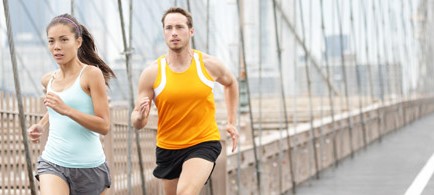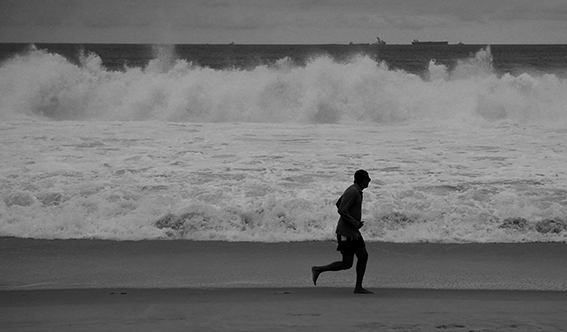Runner’s Knee is a common overuse injury that can hijack sports performance regardless of level. Toby Cryne examines the condition, how itֳ caused and how you can fast track your sports recovery.
Runner’s Knee is a condition that plagues athletes of every ilk from recreational runners to full time professionals. It is a condition which, if left untreated or ignored can be exceptionally debilitating in the long run (no pun intended), trust me I have been there.

Over the past ten years I have learned however, that with quick action and savvy rehabilitation, one can recover from the condition swiftly and with minimal discomfort.
What is Runner’s Knee?
Runner’s Knee is a catch-all umbrella term for a variety of issues that can occur within the knee joint. Known in the professional sphere as Patellofemoral pain syndrome the condition is normally caused by a tight Iliotibial Band which causes misalignment in the joint.[1] Probably the most common running injury that one can get, hence itֳ nickname, the condition is characterised by focused pain on the patella. Runner’s Knee is a condition that effects up to 10% of runners at some stage in their running life.[2]

The symptoms of Runner’s Knee vary depending on the localised area that is uncomfortable:
- Pain above the knee: Quadriceps &/or gluteal dysfunction, thigh bone inward rotation, hamstring tightness at the hip joint or a tight IT-band.
- Pain at the knee: Tight knee structure (lateral retinaculum), patella tilt/rotation or poor alignment.
- Pain below the knee: Tight calves, shin bone outward rotation, excess ankle joint pronation.[3]
These can include weakness in the joint, pain whilst running which increases when one runs at elevation, inability to bear weight, a gradual dull ache which can become painful enough to cause the runner to stop and localised pain in and around the lateral epicondyle of the joint (the bony bit on the outside).[4]If the condition is left untreated and the runner carries on training however, this pain can become less localised due to extra strain being placed on surrounding ligaments and joints.
What are the causes of Runner’s Knee?
Runner’s Knee can be caused by any number of factors such as:
- Overuse: Probably the most common cause of Runner’s Knee is down to simple wear and tear. Increasing mileage far beyond your capabilities causes irritation in the kneecap, overstretches tendons highlights misalignments and Iliotibial Band tightness causing pain and discomfort due to poor structure of the joint.
- Trauma: Due to the kneeֳ delicacy any sudden impact can cause tearing and stretching of the ligaments within the joint.
- Poor alignment: When the bodyֳ physical structure is out of whack, the impact stresses placed on it will not be evenly distributed. This causes additional weight distribution on the knees which subsequently damages the joint and can be caused by either a tight IT Band or poor spinal positioning.[5]
- Poor gait: Over or under pronation in the feet causes the joint to twist in an unnatural position. This again places additional stress on the joint which can tear or rupture ligaments and cartilage.
- Poor Quadricep strength: Poor quadriceps strength coupled with an overtly tight IT Band causes the band to pull the knee out of line, placing large amounts of stress on the joint in an unnatural position.
Rehabilitation for Runner’s Knee
Runner’s Knee is an inflammatory issue in one or more of the previous mentioned muscle groups. As such, the first point of action is to resist exercises which antagonise the joint. Non-impact sports such as cycling and swimming are ideal for those that need to keep training, for everyone else; rest is normally the best option.
If the pain has become harsh enough to disrupt normal day-to-day activities, a doctor may prescribe anti-inflammatory medication such as Non-Steroidal Anti Inflammatory medication. If the condition does not alleviate through rest and anti-inflammatories the next step is to pursue one of the following avenues:
- Regular foam rolling: Foam rolling directly on the IT Band will help to increase the elasticity of the fascia and return the knee back to its original positioning. Using a roller or massage ball in and around the buttocks will help to release tight muscles and ligaments which can also cause misalignment. Check out our foam rollers today!
- Chiropody/physiotherapy: For those that are built slightly wonky or those suffering from recent trauma, chiropody and physiotherapy can both be of massive benefit. If you suffer from a misaligned spine this can cause additional stress on the knee due to additional weight bearing. A chiropractor will straighten the spine and help to correct poor posture. Physiotherapy is a great option for those that are suffering from muscle imbalances. A physiotherapist will be able to determine tight muscles and ligaments, perform myofascial release to balance out the problem areas and determine which muscles need strengthening.
Exercises to prevent Runner’s Knee
If the condition is only mild, a number of exercises can help you correct imbalances in the musculoskeletal system. Try implementing the following into your resistance training or core work:
Straight Leg Raise
Vastus Medialis Obliques Exercise
PhysioRoom stock the ultimate knee injury rehabilitation tools
If you are a sufferer of runners knee and are seeking a knee brace that can provide you with the support an pain relief that you require to complete every day and sporting activities, then you are in the right place.
At PhysioRoom we are proud to supply a variety of hinge-free knee braces that can effectively combat the pain associated with Runner’s Knee. So, experience the support that you need by checking our our range of Hinge Free Knee Braces now!
References
[1] http://www.runnersworld.com/tag/runners-knee
[2] http://www.physioroom.com/sports/running/top_5_running_injuries_3.php
[3] http://www.mcworthopaedics.com/pdf/hoch-anne/patellofemoral-pain-syndrome.pdf
[4] http://www.sportsinjuryclinic.net/sport-injuries/knee-pain/iliotibial-band-syndrome
[5] http://www.webmd.com/pain-management/knee-pain/runners-knee


